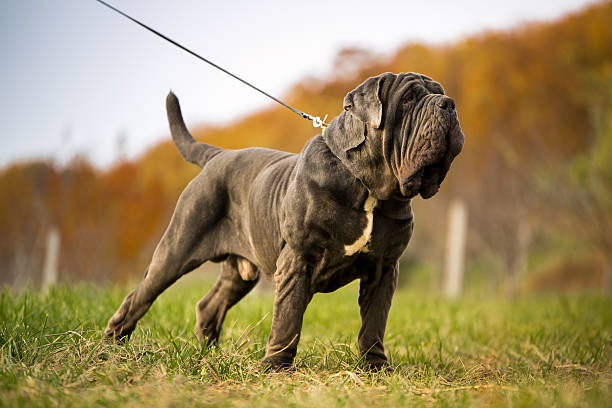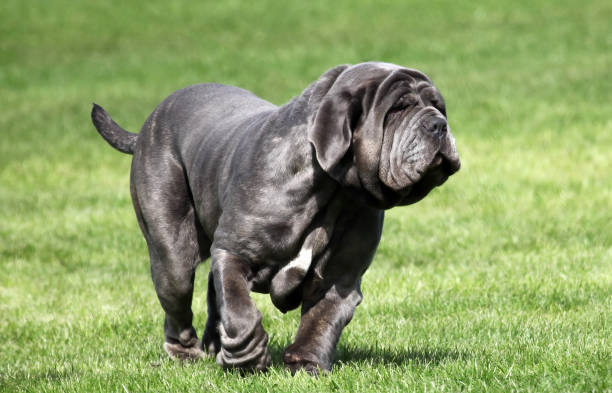Neapolitan Mastiff

Breed History:
The Neapolitan Mastiff, also known as the Mastino Napoletano, is an ancient Italian breed with origins dating back to the Roman Empire. Bred as a guardian and war dog, it was developed to protect property and defend families. The breed traces its lineage to the Molossian war dogs of antiquity, evolving over centuries in southern Italy, particularly around Naples, hence the name.
The modern Neapolitan Mastiff retains its intimidating presence and protective nature, a result of centuries of selective breeding for strength, loyalty, and guarding instincts. The blue Neapolitan Mastiff, a variant with a striking grey-blue coat, is especially admired for its majestic appearance and imposing stature. Despite its fearsome looks, the breed is known for its calm and affectionate demeanour with family.
Considering adopting a Neapolitan Mastiff or a similar giant breed? Check out our page "How to look after a Great Dane" detailing what to consider before adopting and our recommended products for a Great Dane and other giant dog breeds.
|
Gender |
Height |
Weight |
|
Male |
65–75 cm |
60–70 kg |
|
Female |
60–70 cm |
50–60 kg |
Size – Giant
Life Expectancy: 8–10 years

Breed Appearance:
The Neapolitan Mastiff is a massive, muscular dog with loose, wrinkled skin and a heavy, lumbering gait. Its most iconic features include deep facial folds, a prominent dewlap, and a broad, square-shaped head with a short, powerful muzzle. The eyes are deeply set and often partially hidden by folds, giving it a serious and contemplative expression.
The blue coat is short, dense, and smooth, with a striking grey-blue hue that enhances its noble and formidable look. The Neapolitan Mastiff carries itself with dignity, its body heavy-boned and covered in abundant skin, contributing to its unmistakable silhouette. Its tail is thick at the base and tapers to a point, typically carried low.
Breed Type – Family/Guard:
Primarily a guardian breed, the Neapolitan Mastiff is a devoted protector of its home and family. It is naturally wary of strangers and highly territorial, making it one of the most effective watchdogs. However, it is not aggressive without cause—it is calm, steady, and deliberate in its actions, intervening only when it perceives a real threat.
With its family, the Neapolitan is deeply loyal and affectionate, often forming a close bond with one person. It is known for being gentle with children and tolerant of household pets when properly socialised. Its guarding instincts are instinctual and require no training to activate, though early obedience and exposure to various environments are essential for balance.

Training:
Training the Neapolitan Mastiff requires confidence, patience, and consistency. Intelligent but independent, the breed responds best to calm, firm leadership and positive reinforcement. It is not easily impressed by repetition or harsh corrections, and forceful methods can damage the trust between dog and owner.
Socialisation from a young age is critical to ensure the dog grows into a stable and well-mannered adult. Due to its large size and strength, early obedience training is vital, especially for leash manners and basic commands. The Neapolitan is not highly energetic but needs mental stimulation and structured routines to avoid becoming bored or stubborn.
Health & Care:
The Neapolitan Mastiff, while robust in appearance, has a relatively short lifespan and can be prone to several health concerns. Common issues include hip and elbow dysplasia, cherry eye, heart problems, and bloat (gastric torsion), a life-threatening condition that requires immediate veterinary attention.
Due to its heavy frame, joint care is critical, particularly during its growth phase when bones and muscles are still developing. A high-quality, joint-supportive diet, regular vet check-ups, and controlled exercise are essential. Owners should also maintain the wrinkles and folds by gently cleaning and drying them to prevent skin infections.

Living Conditions:
The Neapolitan Mastiff is best suited to homes with ample space and a securely fenced yard. While it can adapt to indoor living, its size and strength mean it needs room to move around comfortably. Apartment life is generally not ideal unless accommodations are spacious and there is access to outdoor areas for exercise.
This breed does not tolerate extreme heat well due to its heavy build and short muzzle, so cool environments and shaded rest areas are important. It is a quiet dog indoors, often lounging for hours, but it remains alert to its surroundings and will react if it senses danger. A calm household with consistent routines suits the Neapolitan best.
Exercise:
Though not a high-energy breed, the Neapolitan Mastiff requires daily walks and moderate activity to stay fit and prevent obesity. Short walks twice a day, along with some supervised play in a yard, are usually sufficient. Overexertion, especially in young dogs, should be avoided to prevent joint damage.
Due to its guarding instincts, the Neapolitan should not be let off-leash in unsecured areas. Mental stimulation, such as scent games or gentle training sessions, helps keep the dog engaged without physical strain. Hot weather can quickly overwhelm this breed, so exercise should be limited during peak temperatures.
Grooming:
The short, smooth coat of the blue Neapolitan Mastiff is easy to care for, requiring only weekly brushing to remove loose hair and keep the coat healthy. However, the skin folds and wrinkles need more attention—daily cleaning with a damp cloth and thorough drying are essential to prevent moisture buildup and bacterial infections.
Bathing should be done occasionally with a mild dog shampoo. Ear cleaning, nail trimming, and regular dental care are important parts of the grooming routine. The breed’s eyes should also be monitored for signs of irritation, particularly due to its drooping lower eyelids and loose skin around the face.

Advantages:
-
Loyal and protective; excellent natural guardian for home and family
-
Gentle and affectionate with loved ones, especially when socialised early
-
Calm and quiet indoors; not overly demanding in terms of exercise
-
Unique and noble appearance with a strong, imposing presence
-
Minimal shedding and easy coat maintenance
Disadvantages:
-
Requires experienced handling due to size, strength, and stubborn nature
-
Prone to health issues, especially joint problems and skin infections
-
Shorter lifespan compared to smaller breeds
-
Daily maintenance of skin folds is necessary to prevent infections
-
Not suited for hot climates or small living spaces
-
Can be wary of strangers and other animals without proper socialisation

